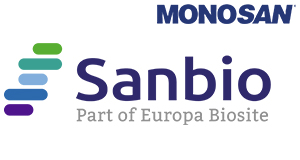Mouse anti-Hu CD3 Purified, clone MEM-92 (Monoclonal)
Mouse anti-Hu CD3 Purified, clone MEM-92 (Monoclonal)
Artikelnummer
SANMON23164
Verpackungseinheit
0,1 mg
Hersteller
Sanbio / Monosan
Verfügbarkeit:
wird geladen...
Preis wird geladen...
Clone Number: MEM-92
Immunogen: Human peripheral blood lymphocytes.
Concentration: 1 mg/ml
Format: Purified by sequential steps of physicochemical fractionation (differential precipitation and solid-phase chromatography methods).
Storage buffer: Tris buffered saline (TBS), pH 8.0, 15 mM sodium azide
Additional info: CD3 complex is crucial in transducing antigen-recognition signals into the cytoplasm of T cells and in regulating the cell surface expression of the TCR complex. T cell activation through the antigen receptor (TCR) involves the cytoplasmic tails of the CD3 subunits CD3 gamma, CD3 delta, CD3 epsilon and CD3 zeta. These CD3 subunits are structurally related members of the immunoglobulins super family encoded by closely linked genes on human chromosome 11. The CD3 components have long cytoplasmic tails that associate with cytoplasmic signal transduction molecules. This association is mediated at least in part by a double tyrosine-based motif present in a single copy in the CD3 subunits. CD3 may play a role in TCR-induced growth arrest, cell survival and proliferation. The CD3 antigen is present on 68-82% of normal peripheral blood lymphocytes, 65-85% of thymocytes and Purkynje cells in the cerebellum. It is never expressed on B or NK cells. Decreased percentages of T lymphocytes may be observed in some autoimmune diseases.SpecificityThe mouse monoclonal antibody Ber-H8 recognizes extracellular part of CD30 (Ki-1 antigen), a 105 kDa single chain glycoprotein expressed on Hodgkin's and Reed-Sternberg cells; it is also found in Burkitt's lymphomas, virus-infected T and B lymphocytes, and on normal B and T lymphocytes after activation (T lymphocytes that produce Th2-type cytokines and on CD4+/CD8+ T lymphocytes that co-express CD45RO and the IL4 receptor).Application detailsFlow cytometry: Recommended dilution: 1-5 µg/ml
Immunogen: Human peripheral blood lymphocytes.
Concentration: 1 mg/ml
Format: Purified by sequential steps of physicochemical fractionation (differential precipitation and solid-phase chromatography methods).
Storage buffer: Tris buffered saline (TBS), pH 8.0, 15 mM sodium azide
Additional info: CD3 complex is crucial in transducing antigen-recognition signals into the cytoplasm of T cells and in regulating the cell surface expression of the TCR complex. T cell activation through the antigen receptor (TCR) involves the cytoplasmic tails of the CD3 subunits CD3 gamma, CD3 delta, CD3 epsilon and CD3 zeta. These CD3 subunits are structurally related members of the immunoglobulins super family encoded by closely linked genes on human chromosome 11. The CD3 components have long cytoplasmic tails that associate with cytoplasmic signal transduction molecules. This association is mediated at least in part by a double tyrosine-based motif present in a single copy in the CD3 subunits. CD3 may play a role in TCR-induced growth arrest, cell survival and proliferation. The CD3 antigen is present on 68-82% of normal peripheral blood lymphocytes, 65-85% of thymocytes and Purkynje cells in the cerebellum. It is never expressed on B or NK cells. Decreased percentages of T lymphocytes may be observed in some autoimmune diseases.SpecificityThe mouse monoclonal antibody Ber-H8 recognizes extracellular part of CD30 (Ki-1 antigen), a 105 kDa single chain glycoprotein expressed on Hodgkin's and Reed-Sternberg cells; it is also found in Burkitt's lymphomas, virus-infected T and B lymphocytes, and on normal B and T lymphocytes after activation (T lymphocytes that produce Th2-type cytokines and on CD4+/CD8+ T lymphocytes that co-express CD45RO and the IL4 receptor).Application detailsFlow cytometry: Recommended dilution: 1-5 µg/ml
| Artikelnummer | SANMON23164 |
|---|---|
| Hersteller | Sanbio / Monosan |
| Hersteller Artikelnummer | MON23164 |
| Verpackungseinheit | 0,1 mg |
| Mengeneinheit | STK |
| Reaktivität | Human |
| Klonalität | Monoclonal |
| Methode | Immunoprecipitation, Flow Cytometry |
| Isotyp | IgM |
| Wirt | Mouse |
| Konjugat | Unconjugated |
| Produktinformation (PDF) |
|
| MSDS (PDF) |
|

 English
English







